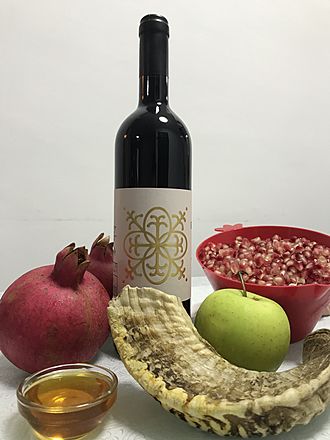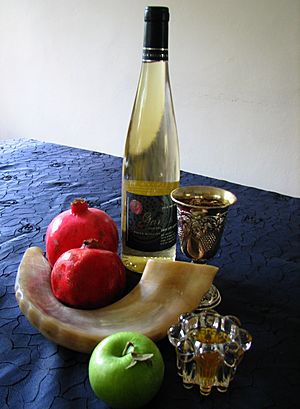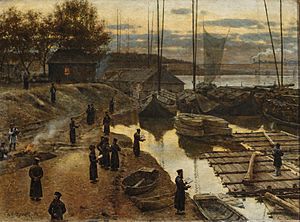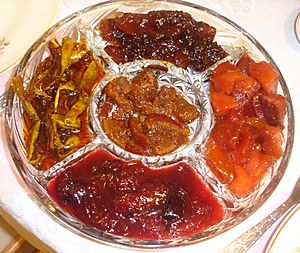Rosh Hashanah facts for kids
Quick facts for kids Rosh HaShanah |
|
|---|---|

A shofar, pomegranates, wine, apple and honey – symbols of the Rosh HaShanah holiday
|
|
| Official name | ראש השנה |
| Also called | Jewish New Year |
| Observed by | Jews |
| Type | Jewish |
| Observances | Praying in synagogue, personal reflection, and hearing or blowing the shofar. |
| Begins | Start of first day of Tishrei |
| Ends | End of second day of Tishrei |
| Date | 1 Tishrei, 2 Tishrei |
| 2022 date | Sunset, 25 September – nightfall, 27 September |
| 2023 date | Sunset, 15 September – nightfall, 17 September |
| 2024 date | Sunset, 2 October – nightfall, 4 October |
| 2025 date | Sunset, 22 September – nightfall, 24 September |
Rosh Hashanah is a Jewish holiday commonly referred to as the "Jewish New Year." It is observed on the first day of Tishrei, the seventh month of the Hebrew calendar. The festival lasts for two days.
Rosh Hashanah is the first of the High Holidays or Yamim Noraim ("Days of Awe"), or Asseret Yemei Teshuva (The Ten Days of Repentance) which are days specifically set aside to focus on repentance that conclude with the holiday of Yom Kippur. The story of Rosh Hashanah is about Abraham and his belief in God when he was told to sacrifice his son.
Contents
Duration and timing
Rosh Hashanah occurs 163 days after the first day of Passover (Pesach). In terms of the Gregorian calendar, the earliest date on which Rosh Hashanah can fall is September 5, as happened in 1842, 1861, 1899 and 2013. The latest Gregorian date that Rosh Hashanah can occur is October 5, as happened in 1815, 1929 and 1967, and will happen again in 2043. After 2089, the differences between the Hebrew calendar and the Gregorian calendar will result in Rosh Hashanah falling no earlier than September 6. Starting in 2214, the new latest date will be October 6.
Although the Jewish calendar is based on the lunar cycle, so that the first day of each month originally began with the first sighting of a new moon, since the fourth century it has been arranged so that Rosh Hashanah never falls on a Sunday, Wednesday, or Friday.
The Torah defines Rosh Hashanah as a one-day celebration, and since days in the Hebrew calendar begin at sundown, the beginning of Rosh Hashanah is at sundown at the end of 29 Elul. The rules of the Hebrew calendar are designed such that the first day of Rosh Hashanah will never occur on the first, fourth, or sixth day of the Jewish week (i.e., Sunday, Wednesday, or Friday). Since the time of the destruction of the Second Temple of Jerusalem in 70 CE and the time of Rabban Yohanan ben Zakkai, normative Jewish law appears to be that Rosh Hashanah is to be celebrated for two days, because of the difficulty of determining the date of the new moon. Nonetheless, there is some evidence that Rosh Hashanah was celebrated on a single day in Israel as late as the thirteenth century CE. Orthodox and Conservative Judaism now generally observe Rosh Hashanah for the first two days of Tishrei, even in Israel where all other Jewish holidays dated from the new moon last only one day. The two days of Rosh Hashanah are said to constitute "Yoma Arichtah" (Aramaic: "one long day"). In Reform Judaism, while most congregations in North America observe only the first day of Rosh Hashanah, some follow the traditional two-day observance as a sign of solidarity with other Jews worldwide. Karaite Jews, who do not recognize Rabbinic Jewish oral law and rely on their own understanding of the Torah, observe only one day on the first of Tishrei, since the second day is not mentioned in the Written Torah.
Prayer service
On Rosh Hashanah day, religious poems, called piyyutim, are added to the regular services. A special prayer book, the mahzor, is used on Rosh Hashanah and Yom Kippur (plural mahzorim). A number of additions are made to the regular service, most notably an extended repetition of the Amidah prayer for both Shacharit and Mussaf. The Shofar is blown during Mussaf at several intervals. (In many synagogues, even little children come and hear the Shofar being blown.) Biblical verses are recited at each point. According to the Mishnah, 10 verses (each) are said regarding kingship, remembrance, and the shofar itself, each accompanied by the blowing of the shofar. A variety of piyyutim, medieval penitential prayers, are recited regarding themes of repentance. The Alenu prayer is recited during the repetition of the Mussaf Amidah.
The Mussaf Amidah prayer on Rosh Hashanah is unique in that apart from the first and last 3 blessings, it contains 3 central blessings making a total of 9. These blessings are entitled "Malchuyot" (Kingship, and also includes the blessing for the holiness of the day as is in a normal Mussaf), "Zichronot" (Remembrance) and "Shofarot" (concerning the Shofar). Each section contains an introductory paragraph followed by selections of verses about the "topic". The verses are 3 from the Torah, 3 from the Ketuvim, 3 from the Nevi'im, and one more from the Torah. During the repetition of the Amidah, the Shofar is sounded (except on Shabbat) after the blessing that ends each section.
Symbolic foods

Rosh Hashanah meals usually include apples dipped in honey to symbolize a sweet new year. Other foods with a symbolic meaning may be served, depending on local minhag ("custom"), such as the head of a fish (to symbolize the prayer "let us be the head and not the tail").
Many communities hold a "Rosh Hashanah seder" during which blessings are recited over a variety of symbolic dishes. The blessings have the incipit "Yehi ratzon", meaning "May it be Thy will." In many cases, the name of the food in Hebrew or Aramaic represents a play on words (a pun). The Yehi Ratzon platter may include apples (dipped in honey, baked or cooked as a compote called mansanada); dates; pomegranates; black-eyed peas; pumpkin-filled pastries called rodanchas; leek fritters called keftedes de prasa; beets; and a whole fish with the head intact. It is also common to eat stuffed vegetables called legumbres yaprakes.
Some of the symbolic foods eaten are dates, black-eyed peas, leek, spinach and gourd, all of which are mentioned in the Talmud: “Let a man be accustomed to eat on New Year's Day gourds (קרא), and fenugreek (רוביא), leeks (כרתי), beet [leaves] (סילקא), and dates ( תמרי).”
Pomegranates are used in many traditions, to symbolize being fruitful like the pomegranate with its many seeds. The use of apples dipped in honey, symbolizing a sweet year, is a late medieval Ashkenazi addition, though it is now almost universally accepted. Typically, round challah bread is served, to symbolize the cycle of the year. From ancient to quite modern age, lamb head or fish head were served. Nowadays, gefilte fish and lekach are commonly served by Ashkenazic Jews on this holiday. On the second night, new fruits are served to warrant inclusion of the shehecheyanu blessing.
Tashlikh

The ritual of tashlikh is performed on the afternoon of the first day of Rosh Hashanah by Ashkenazic and most Sephardic Jews (but not by Spanish & Portuguese Jews or some Yemenites). Prayers are recited near natural flowing water, and one's sins are symbolically cast into the water. Many also have the custom to throw bread or pebbles into the water, to symbolize the "casting off" of sins. In some communities, if the first day of Rosh Hashanah occurs on Shabbat, tashlikh is postponed until the second day. The traditional service for tashlikh is recited individually and includes the prayer "Who is like unto you, O God...And You will cast all their sins into the depths of the sea", and Biblical passages including Isaiah 11:9 ("They will not injure nor destroy in all My holy mountain, for the earth shall be as full of the knowledge of the Lord as the waters cover the sea") and Psalms 118:5–9, Psalms 121 and Psalms 130, as well as personal prayers. Though once considered a solemn individual tradition, it has become an increasingly social ceremony practiced in groups. Tashlikh can be performed any time until Hoshana Rabba, and some Hasidic communities perform Tashlikh on the day before Yom Kippur.
Greetings
The Hebrew common greeting on Rosh Hashanah is Shanah Tovah (Hebrew: שנה טובה;), which translated from Hebrew means "[have a] good year". Often Shanah Tovah Umetukah (Hebrew: שנה טובה ומתוקה), meaning "[have a] Good and Sweet Year", is used. In Yiddish the greeting is אַ גוט יאָר "a gut yor" ("a good year") or אַ גוט געבענטשט יאָר "a gut gebentsht yor" ("a good blessed year").The formal Sephardic greeting is Tizku Leshanim Rabbot ("may you merit many years"), to which the answer is Ne'imot VeTovot ("pleasant and good ones").
A more formal greeting commonly used among religiously observant Jews is Ketivah VaChatimah Tovah (Hebrew: כְּתִיבָה וַחֲתִימָה טוֹבָה), which translates as "A good inscription and sealing [in the Book of Life]", or L'shanah tovah tikatevu v'tichatemu meaning "May you be inscribed and sealed for a good year". After Rosh Hashanah ends, the greeting is changed to G’mar chatimah tovah (Hebrew: גמר חתימה טובה) meaning "A good final sealing", until Yom Kippur. After Yom Kippur is over, until Hoshana Rabbah, as Sukkot ends, the greeting is Gmar Tov, "a good conclusion".
Images for kids
-
Traditional Rosh Hashanah foods: Apples dipped in honey, pomegranates, wine for kiddush
See also
 In Spanish: Rosh Hashaná para niños
In Spanish: Rosh Hashaná para niños




